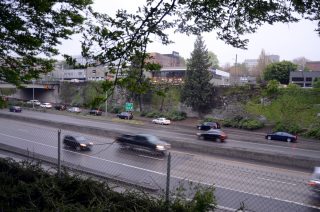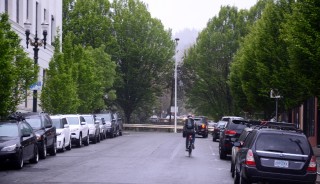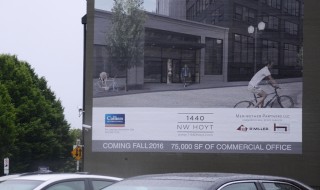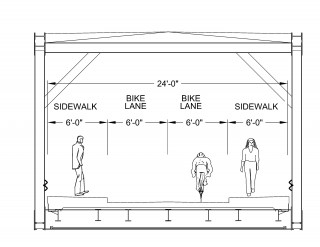
(Photos: M. Andersen/BikePortland)
Part of NW Portland Week.
Someday, quite possibly two months from tomorrow, northwest Portland will finally land the biggest bike infrastructure investment in its modern history.
The Flanders Crossing bridge across Interstate 405 came close to reality eight years ago, then died amid election politics. But it’s too good an idea to stay dead — and events of the last few weeks suggest that it may be on the edge of a breakthrough.
Last month, the new $5.9 million biking-walking bridge that would allow a continuous low-traffic neighborhood greenway from the Northwest District straight to the Steel Bridge via Flanders Street was scored third out of 22 biking and walking projects statewide for Connect Oregon, a Lottery-funded program that offers one of Oregon’s few sources for new off-road transportation investments.
‘The volumes would be huge’

If Flanders Crossing’s score survives the second and third rounds of project rankings, the City of Portland says work could begin next year.
On the day the bridge opens, the city estimated in its grant application, it’ll start drawing 3,000 crossings every day as people change their routes to avoid the uncomfortable freeway crossings at Everett, Glisan and Couch.
The city expects crossings of the biking-walking bridge to soar to 9,100 per day, more than summer bike counts across the Hawthorne Bridge.
Once a complete neighborhood greenway can be built on Flanders — speed bumps, stop signs and everything else that would give northwest Portland its first truly all-ages bikeway — the city expects crossings of the $5.9 million biking-walking bridge to soar to 9,100 per day, more than the summer bike counts across the Hawthorne Bridge and about five times the daily bike ridership across the $135 million Tilikum Crossing. By 2035, the city projected daily crossings would climb to 11,600.
“The volumes here for that Flanders Street project would be huge,” said Susan Peithman, who sits on the biking-walking modal committee that gave high marks to the project last month. “I don’t think there’s anyone who argues against the fact that it will have a significant impact.”
“Just look at the connections you would be able to make from the Steel Bridge all the way to Northwest,” said Reza Farhoodi, a biking advocate who co-chairs the planning and transportation committee for the Pearl District Neighborhood Association. “If you look at the Naito crossing and Flanders bridge in tandem, it really does make sense. It’s such a straight shot across the entire quadrant, from the West Hills down to the waterfront.”
By 2019, bridge would have 21 times more users per dollar spent than the CRC would have had by 2030
Because the span is relatively short and the demand for better crossings of I-405 is already so high, Flanders Crossing would be one of the city’s most cost-efficient bridge projects.
That’s true even if you measure the 9,100 expected trips the bridge could be carrying in 2019 and compare that to the number of people using other bridge projects up to 15 years after their construction.

Part of the reason this bridge would be so well-used is that the Pearl District, just east of the proposed bridge, has been adding jobs just as fast as the area immediately west of the bridge has been adding housing. A Bureau of Planning and Sustainability study found the Pearl added 3,200 jobs from 2006 to 2013, despite the Great Recession.
But despite the bridge’s economic significance, $5.9 million is a lot of money in a state with many needs.
Backers of the Flanders Bridge say it’s unique because, unlike many projects, it can be paid for almost entirely out of the fees (known as system development charges or SDCs) that developers pay the city when they build new homes and workplaces.
The city would spend $3 million of development fees on the Flanders Bridge. It’s asking the state lottery fund to contribute the other $2.9 million.
Though there’s no law mandating that the fees be spent near new development, the purpose of the fees is to construct the capacity-boosting street improvements that will serve those developments. And northwest Portlanders point out that housing projects in their area have been filling Portland Bureau of Transportation coffers with cash that can’t legally be spent on road maintenance.
“By my math in the last five years, PBOT has probably collected over $7 million in SDCs just from apartments in NW and the Pearl,” said Iain MacKenzie, a northwest Portlander who publishes the development-tracking website NextPortland. “As far as bike infrastructure goes we’ve gotten a diverter at NW 10th & Marshall and a re-striping of NW Everett.”
State committees will decide project’s fate
If Connect Oregon helps pay for this bridge, it’d be Portland’s biggest payoff yet from a state law, unexpectedly won by the Bicycle Transportation Alliance in 2013, that let the state use lottery money for biking and walking projects of economic significance.
According to the city’s Connect Oregon grant application, PBOT would put up $3 million of its SDC funds for the Flanders Bridge. It’s asking the state lottery fund to contribute the other $2,877,000.
The next step in the state decision process is a regional review committee meeting on May 2 at ODOT’s regional headquarters. If the project scores well there, it’ll be positioned well for the state’s final review committee on June 14-15.
If cost-efficiency and economic payoff aren’t enough to carry the day there, we reported in December that the city and other bridge advocates have one more card to play on the bridge’s behalf: at 24 feet wide, the new bridge would be able to carry ambulances, fire trucks and construction vehicles.
The idea isn’t to open the bridge to big rigs under normal circumstances. But because the span would be built to modern seismic standards, someday soon Flanders Crossing might not just be the best way to get across Interstate 405.
It might be the only way to get across Interstate 405.
“It’d be pretty much the only bridge left standing if we ever had a 9.0 earthquake,” Farhoodi said.
— Michael Andersen, (503) 333-7824 – michael@bikeportland.org
Our work is supported by subscribers. Please become one today. .
The post The Flanders Crossing could be the city’s best bridge project in many years appeared first on BikePortland.org.
from Front Page – BikePortland.org http://ift.tt/1Wu5ssS



No comments:
Post a Comment